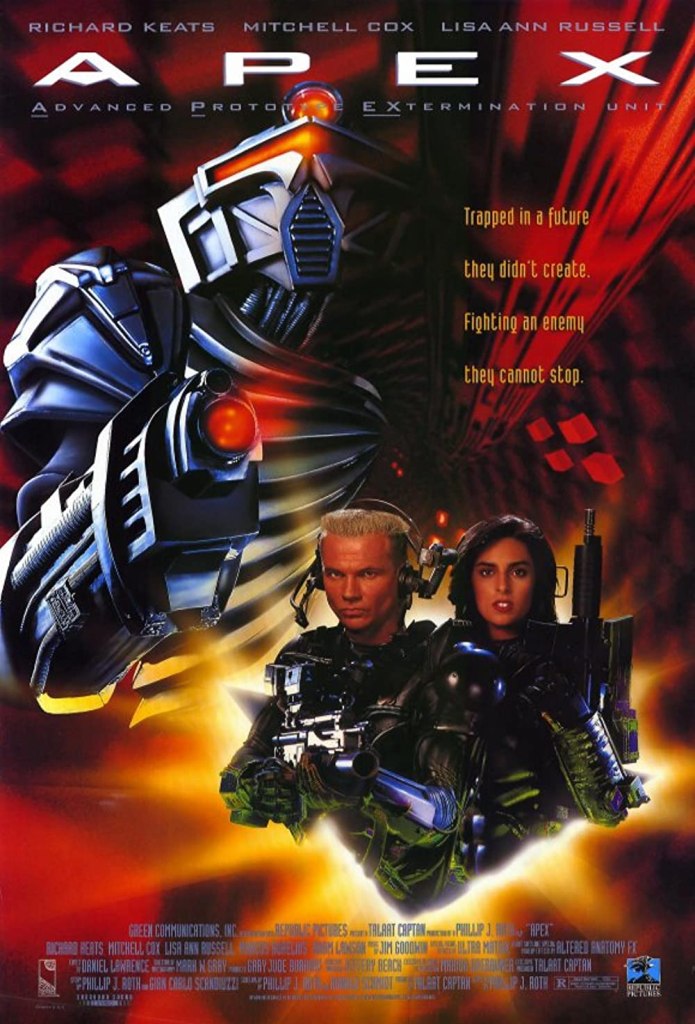Twice can be nice, but Matty thinks DTV demigod Phillip J. Roth’s sophomore sci-fi flick is a bit of a struggle.
If A.P.E.X. were an episode of Sesame Street, it’d be brought to you by the number two.
Phillip J. Roth’s second sci-fi flick, A.P.E.X. is also the second of three robot-based films the helmer made with his Sitting Target (1990) and Red Snow (1990) producer, Talaat Captan; the midpoint in a loose trilogy bookended by Prototype (1992) and their final collaboration, Digital Man (1995). A.P.E.X. itself, meanwhile, is a film of two distinct halves. It’s perched between the brilliant and the serviceable, and dualism is woven throughout its fabric — conceptually and practically.
Built from a story conceived by Roth and Prototype co-scenarist Gian-Carlo Scandiuzzi (another two), and hashed out to feature length by Roth and frequent collaborator Ronald Schmidt (and another two), A.P.E.X.’s ambitious screenplay swirls around a pair of timelines that has much of the film’s cast occupying dual roles. The thrust of the plot is wonderful and packed with several clever and provocative ideas. The best are those that allow Roth to explore his go-to theme of identity; a topic that’s consumed the director since his debut, Bad Trip (1988). In A.P.E.X., a scientist experimenting with time travel (Richard Keats) winds up in a post-apocalyptic alternate universe of his own inadvertent creation, whereupon he’s forced to team with a ragtag bunch of mercs to thwart the eponymous battle droids (“Advanced Prototype EXploration Units”) and find the right loop home.
Having provided the same awesome service on Prototype, the A.P.E.X.s are designed by Robert J. Marino and look phenomenal. It’s tempting to rule them the finest creations in the entire robo-schlock canon [1]. Indicative of Roth’s subsequent status as straight-to-video sci-fi’s greatest technical innovator thanks to his early adoption of CGI, A.P.E.X.’s VFX are likewise excellent. They’re as impressive as those in Brett Leonard’s The Lawnmower Man (1992) — a picture that, for all its flaws, pushed the limits of what could be achieved in the low to mid-budget genre arena with just a few computers and a group of eager to please digital artists. Less impressive, though, is almost everything else.
Despite taking an admirable amount of big swings, Roth struggles to bring everything together and A.P.E.X. is hindered by a strange, uncharacteristic sloppiness. The nitty-gritty of Roth and Schmidt’s script is stricken with an inordinate amount of ‘huh?’ moments that frequently contradict the logic established often only the scene prior, and the cast are uniformly terrible (even usually dependable Roth regular Marcus Aurelius; he’s just squawk-y and annoying here). Worse, unlike the gloomy and beautifully realised future-shock world of Prototype, A.P.E.X. comes across as cheap and ugly. It’s as if Roth has gone back a step, reverting to the relatively indistinguishable meat n’ potatoes aesthetic of his earlier Portland-shot programmers (Bad Trip, Fatal Revenge (1989) et al) rather than pushing forward with the sort of stylistic, atmospheric and textural flourishes that came to the fore in Prototype, and define later joints such as Digital Man, Darkdrive (1997), Total Reality (1997), and Boa (2001). The Kaiser Steel Mill in Fontana is a great location and a welcome sight; but if you compare its use in A.P.E.X. with how Roth presented it in Prototype — or, in a wider sense, how Paul Verhoeven and Albert Pyun harnessed the place in their robo-schlock trendsetters RoboCop (1987) and Nemesis (1992) — it’s a mite disheartening, regardless of the amount of robustly orchestrated explosions and gunfights thrown at us.
Featuring the iconic Landmaster from Damnation Alley (1976), A.P.E.X. was co-produced by Republic Pictures who gave the film a brief, fourteen city U.S. theatrical run in March 1994 before issuing it on North American video — drum roll please— two months later [2].
USA ● 1994 ● Sci-Fi, Action ● 98mins
Richard Keats, Mitchell Cox, Lisa Ann Russell, Marcus Aurelius ● Dir. Phillip J. Roth ● Wri. Phillip J. Roth and Ronald Schmidt, from a story by Phillip J. Roth & Gian-Carlo Scandiuzzi

[1] Marino’s Altered Anatomy FX were active from January ’92 to June ’98, when the make-up and prosthetic wiz founded Octopus Creations Incorporated. In addition to his exemplary work on Prototype and A.P.E.X., Marino, a former technician at Steve Johnson’s XFX Inc., was also responsible for Hulk Hogan’s Shep Ramsey costume in Suburban Commando (1991) and the HAND-cuffs in Ate de Jong’s Highway to Hell (1991). His Octopus, erm, creations include designing and inventing a wealth of toys for Mattel, Hot Wheels, and Jakks Pacific.
[2] In the U.K., A.P.E.X. was released on video in April 1994 by the British distributor of Prototype, 20:20 Vision.

